Essential Equipment for Caring for Pet Birds
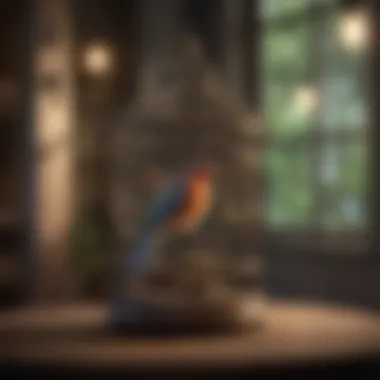
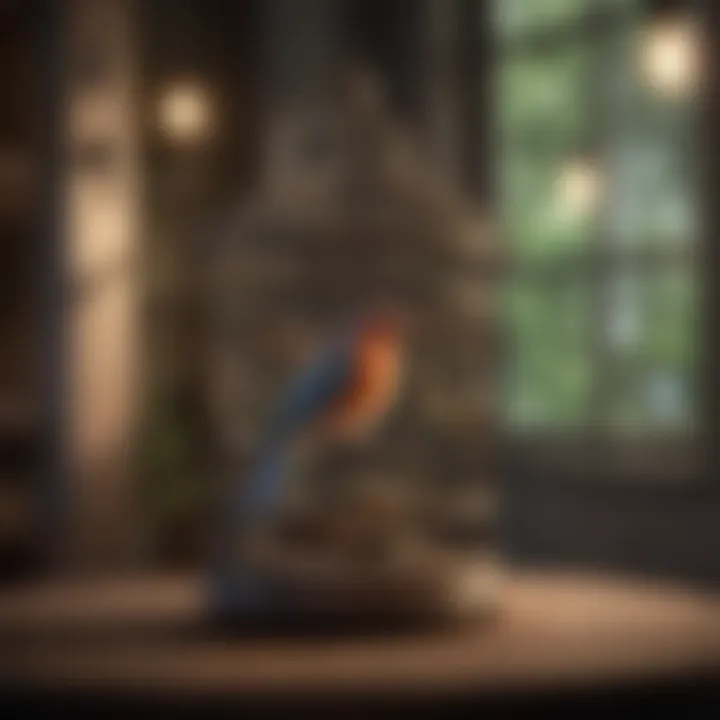
Intro
Caring for pet birds is a rewarding venture, one that calls for comprehensive knowledge about their needs. From making sure they have the right diet to ensuring their environment is safe and enriching, every aspect plays a crucial role in the well-being of our feathered friends. Ironically, while birds can be relatively low maintenance compared to some other pets, they require specialized attention that can often be overlooked. This article endeavors to provide an all-encompassing look at the essential equipment for pet birds, diving into the nuances of their care.
Care Tips
Creating a nurturing habitat requires diligence and knowledge about the essentials. Here, we discuss the key factors in proper care.
Daily Care Routines
Establishing a daily routine is integral to the overall health of a bird. Regular interactions should include feeding, cleaning, and providing stimulation through play. Each species may have unique requirements, but consistency is essential. For example, a parakeet may relish social engagement and can benefit from daily time outside its cage, while a finch may prefer less handling and more time observing.
Cage Setup and Maintenance
The cage serves not merely as a shelter but as a vital space for interaction and play. When selecting a cage, consider aspects such as size and bar spacing appropriate to the species. For instance, larger birds like macaws need ample space to move, whereas cockatiels can thrive in somewhat smaller environments. Maintaining hygiene is equally crucial; clean the cage weekly to prevent bacterial buildup, and replace perches and toys regularly to minimize wear and tear.
Hygiene and Cleaning Practices
Cleaning a bird's environment goes beyond visible mess. It's about safeguarding against diseases. Change the bedding weekly to avoid odor build-up and provide fresh water daily. Since birds are often sensitive to strong smells, using mild, non-toxic cleaners should be a priority. These practices foster a healthier environment, ensuring your birds live a fulfilling life.
Seasonal Care Adjustments
Birds, like humans, feel the effects of changing seasons. In the summer, ensure they stay cool with suitable ventilation. In colder months, consider a heater or extra bedding. These adaptations not only help in maintaining comfort but also enhance the overall quality of life, showing that understanding birds goes beyond mere feeding and cleaning.
Behavioral Insights
Understanding your bird's behavior is essential. Birds have complex emotional landscapes, and reading body language can provide insight.
Understanding Bird Body Language
Birds communicate effectively through their body language. A puffed-up bird might be feeling unwell, while rapid head bobbing usually indicates excitement or contentment. Becoming familiar with these signals can improve the bond you share.
Common Behavioral Issues and Solutions
Behavioral problems can arise for numerous reasons, often linked to their environment or social needs. Aggression can signal discomfort, while excessive screaming often stems from boredom. Implementing positive changes, like offering more toys or varying their routine, can be both beneficial and enriching.
Positive Reinforcement Techniques
Positive reinforcement, such as offering a favored treat for behaviors you want to encourage, is a powerful tool. Birds are quick learners, and adopting an approach that rewards desired behaviors can lead to a more harmonious home.
Social Interaction Needs
Birds are inherently social creatures, needing companionship, whether human or avian. Loneliness can lead to various behavioral issues, thus, ensuring they have interaction, either through playtime or by having a compatible bird buddy, enhances their quality of life.
Nutrition Guides
Nutritional needs vary widely across species, and understanding these can promote health and vitality.
Essential Diet Components
An optimal diet for birds involves a mix of seeds, pellets, fruits, and veggies. Ensure your bird’s diet is balanced; for instance, cockatiels need a variety of seeds and may benefit from fresh greens, while budgies thrive on a different mix.
Safe and Toxic Foods
Being aware of unsafe foods is crucial. Avoid chocolate, avocado, and onion, as these can be harmful to birds. Researching what is good for their health can prevent accidental poisoning and ensure a long, happy life for your pet.
Supplements and Treats
Many birds benefit from the occasional supplement to boost their health. Calcium and vitamin D are particularly important for birds like cockatoos. Treats, if given sparingly, can be a rewarding aspect of their diet, but moderation is key.
Feeding Strategies for Different Species
Different birds have varied feeding styles. Some, like parrots, enjoy foraging, so scattering food around their cage can replicate this behavior and keep them engaged. Each bird can thrive with tailored feeding strategies that consider their natural instincts and nutritional needs.
Wellness and Health
Staying on top of health and wellness ensures longevity in your pet's life.
Routine Health Checkups
Regular veterinary visits are essential for preventative care. A professional can monitor your bird’s health and catch any potential issues before they escalate. Consult with your vet about vaccinations and other frequent health checks.
Identifying Symptoms of Illness
Being attentive to your bird’s behavior is vital. Changes such as lethargy, feather plucking, or unusual droppings can indicate health problems. Quick detection can lead to interventions that might save your pet.
Preventative Care and Vaccinations
Just as with any pet, vaccinations are a key aspect of preventive health care for birds. Discuss with your vet about what shots might be necessary, depending on your bird’s lifestyle and environment.
Mental and Emotional Well-being
The emotional state of your bird cannot be overlooked. Birds are intelligent beings, and mental stimulation keeps them happy. Regular interaction, along with an engaging environment, supports their emotional well-being and fosters a loving relationship.
Enriching Activities
Providing enriching activities is the cornerstone of a happy birdlife.
Toys and Playtime Ideas
Investing in various toys can prevent boredom. Think of puzzles, chewy materials, or items to shred. This not only entertains them but also encourages their natural instincts. Rotate their toys regularly to keep things fresh.
Training and Tricks
Birds can learn impressive tricks, and training fosters a bond. Start with simple commands and gradually increase complexity. This not only helps social interaction but also provides mental stimulation.
Outdoor Activities and Interaction
Socialization and outdoor exposure can greatly benefit birds. Supervised time outside can expose them to natural environments, which is essential for stimulating their senses. Always ensure safety with harnesses if necessary.
DIY Projects for Mental Stimulation
Engaging in DIY projects, like creating simple toys or foraging stations, promotes mental stimulation. Using household items, you can craft enrichments that entertain and challenge your feathered companions.
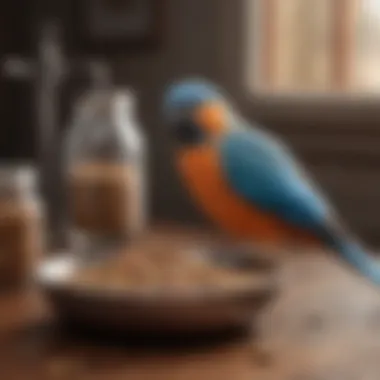
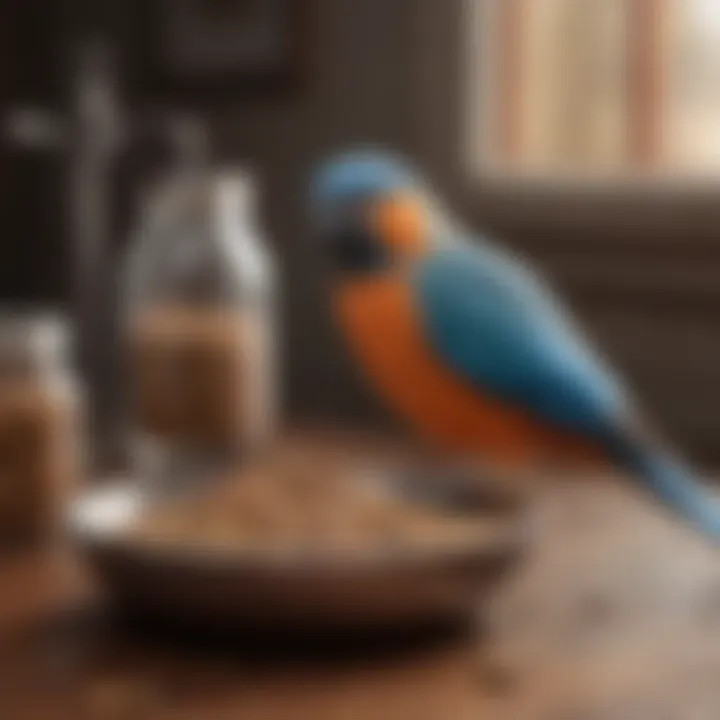
"Creating a stimulating environment for your birds not only feeds their need for activity but also enriches their emotional lives."
Keeping pet birds can be one of life’s delightful pursuits. Understanding their equipment and care needs forms the foundation of a long-lasting, joyous companionship. As we traverse through this guide, it will become clear that the right tools and knowledge significantly impact the well-being of our avian friends.
Understanding the Needs of Pet Birds
Understanding the needs of pet birds goes beyond simply providing food and shelter; it's about tapping into their unique biological and emotional requirements. Birds, as social creatures, require a comprehensive environment that caters to both their physical and psychological well-being. This section lays the groundwork for ensuring that pet birds thrive in their homes.
Physical Requirements
When we talk about the physical needs of pet birds, we are primarily referring to their habitat. The cage is arguably the most significant structure in their lives. It’s not just a prison; it should be their sanctuary, a space where they can feel secure.
- Cage Size: The dimensions of the cage must allow for freedom of movement. Birds like budgerigars and cockatiels thrive in spacious environments where they can spread their wings fully. A good guideline is that bigger is always better.
- Perches: Different perch diameters cater to the natural gripping behaviors of birds. A pole made from natural wood allows them to exercise their feet and helps maintain their talons. Variety is key—adding perches at various heights keeps them active.
- Ventilation: Fresh air is equally crucial for birds as it is for humans. Proper ventilation reduces harmful bacteria and maintains a healthy atmosphere.
Health Considerations
In dealing with this aspect of their needs, also consider keep molds, dust mites, and other allergens at bay. Regular cleaning of the cage not only maintains hygiene but also helps prevent diseases.
Psychological Needs
Delving into the psychological aspects, pet birds are not just feathered companions; they are sentient beings who have their own thoughts and feelings. The environment needs to be enriching in ways that stimulate their minds and encourage natural behaviors.
- Social Interaction: Birds are naturally social creatures. Ignoring their need for interaction can lead to boredom and behavioral issues. Owners should spend time with their birds, and if the household allows, considering companionship—like getting a second bird—could be beneficial.
- Toys and Enrichment: Providing toys isn't just about play; it prevents behavioral problems that arise from boredom. Toys should vary in texture, color, and functionality—some should encourage chewing, others for climbing, and some for solving puzzles.
- Routine and Stability: Birds thrive on routine and predictability. Establishing a daily schedule for feeding, playtime, and interaction helps them feel secure. Significant changes to their routine can induce stress, impacting their mental health.
A healthy bird is a happy bird, and a happy bird requires understanding and thoughtful attention to both its physical and psychological needs.
In summary, pet bird owners must recognize that their feathered friends require more than just a cage and food. By understanding and addressing both their physical and psychological needs, owners can ensure a happy, healthy, and fulfilling life for their birds.
Choosing the Right Cage
Selecting an appropriate cage for your pet bird is not merely about finding the biggest or the cheapest option available. At the end of the day, the cage is the primary habitat for your feathered companion. It serves as their home, play area, and sanctuary all rolled into one. A properly chosen cage can foster their well-being, prevent stress, and support healthy behaviors. When considering which cage to buy, various elements must come into play, from size and material to design features that appeal to the unique needs of your specific bird species.
Cage Size Considerations
Cage size stands as a major pillar in ensuring your bird's happiness and health. A cramped living space can cause serious issues, both physically and mentally. Birds need room to spread their wings and move about freely. Generally speaking, the bigger the cage, the better, but specific dimensions can vary based on the size and species of the bird you own. For example, larger parrots like Macaws may need a cage measuring at least 36 inches wide, while smaller species like Budgies can thrive in cages 24 inches wide.
When assessing size, also consider vertical space. Many birds love to climb, so taller cages are often preferable. Placing various perches at different heights can enhance their well-being by encouraging natural behaviors. The right size cage not only improves health but also reduces stress and enhances the overall quality of life for your pet bird.
- For small birds: A cage that is at least 18 inches in width.
- For medium birds: A minimum width of 24 to 36 inches is suggested.
- For large birds: Cages should ideally provide 36 inches or more in width to accommodate movement.
Material Safety
Now let’s turn the spotlight on cage material—this greatly impacts your bird's environment and safety. Materials like untreated wood, stainless steel, and certain types of non-toxic plastics are more advisable as they pose a lower risk to your bird's health. On the flip side, avoid cages made from galvanized metals, such as zinc, as these can lead to severe health issues if ingested. Additionally, cages painted with lead-based paints or containing treated wood can introduce harmful toxins to your pet.
When checking for material safety, look for cages that have been tested and certified for safety by a recognized authority. It’s always better to err on the side of caution when it comes to your pet's health.
Key Takeaway: Always ensure that the material of the cage is non-toxic. Your bird’s safety should never be compromised for aesthetic appeal.
Design Features
Beyond size and materials, the design of the cage plays an essential role in your bird's happiness. Look for cages with a wide entryway that allows for easy access and cleaning. Avoid cages with horizontal bars, as birds can get entangled or injured.
Consider cages that come equipped with removable trays for easy cleaning and sturdy, adjustable perches to allow for height variations. Also, look for cages that include features like:
- Playtops: Help to keep your bird occupied and provides an additional space to play outside the cage.
- Food and water dishes: Easily accessible and secure to prevent spills.
- Ventilation holes: Ensure proper air circulation within the cage.
Essential Bird Accessories
In the realm of pet bird care, accessories play a pivotal role in the overall well-being of our feathered friends. Accessories are not just trinkets; they are crucial components that enrich birds’ lives, helping them thrive both physically and mentally. Providing the right accessories can mean the difference between a bland cage and a vibrant sanctuary that encourages natural behaviours, exercise, and social interaction.
Perches: Variety and Placement
Perches are not merely bars for birds to stand on; they are an essential element of their environment. The types of perches you choose can significantly influence your pet's comfort and health. Different materials, shapes, and sizes provide opportunities for natural behaviours.
When considering perches, dissimilar types are vital. For instance, natural wood perches, such as those made from manzanita or other non-toxic woods, mimic trees found in the wild. They are often irregular in shape, promoting foot exercise and helping prevent foot disorders that arise from prolonged standing on uniform surfaces.
Moreover, varying the placement of these perches within the cage can affect a bird's activity levels. Placing some higher up encourages flapping and climbing, while lower perches can foster security and resting spots for smaller species.
- Consider the following when choosing perches:
- Diameter: Pick different thicknesses to promote healthy grip and foot muscle use.
- Location: Mix high and low options within the cage space.
- Material: Balance between natural woods and safe synthetic options.
Food and Water Containers
Proper food and water containers are fundamental for maintaining your bird's health. Accessibility matters a great deal. Birds need to have access to fresh food and clean water at all times, and the types of containers you select can either facilitate or hinder this.
Opt for containers that can be easily cleaned and are made from bird-safe materials. Stainless steel bowls are usually a great choice since they are durable and resistant to bacteria. Avoid plastic varieties that can scratch and harbor germs over time.
Furthermore, consider the size and shape of these containers. A bowl that's too deep may make it tough for smaller birds to access the food. An ideal setup could look like this:
- Separate bowls for food and water to prevent contamination.
- Weighted bowls that resist tipping, especially for playful or curious avian companions.
- Gravity feeders for seeds to ensure a constant supply without daily refills.
Nesting Materials
Nesting materials might be often overlooked, but they are incredibly important, especially for breeding birds. The right materials allow birds to engage in natural nesting behaviours, which can reduce stress and improve overall happiness. They are vital in creating a safe, cozy space for laying eggs or simply cuddling.
Commonly used materials might include paper, untreated grass, or coconut fibre. Each species of bird may have specific preferences. For instance:
- Finches enjoy soft grasses and plant materials.
- Canaries prefer natural cotton or sisal threads.
- Parrots can often be seen shredding safe wood or paper products.
To wrap it up, providing various, safe nesting materials tailored to your pet's needs is key. Thus, you maintain that perfect balance of comfort and creativity within their living space.
"Birds need a pinch of creativity to make their nests a home. Give them the right materials, and watch how they work their magic!"
As we continue to look deeper into the essential components for our avian companions, understanding accessories' roles is foundational in creating an enriched living environment.
Dietary Equipment for Pet Birds
Choosing the right dietary equipment is critical when it comes to ensuring your pet bird's well-being. Just like us, birds require a balanced diet, which includes seeds, pellets, and fresh fruits and vegetables. This section will delve into the essential dietary tools that every bird owner should consider, breaking down their significance and benefits.
Seed and Pellet Dispensers
Seed and pellet dispensers are vital components for maintaining a pet bird's diet. These devices keep food fresh, accessible, and mess-free. By dispensing the right amount of seed or pellets at timed intervals, they help prevent overeating, a common issue in birds. It's crucial to select a dispenser that is appropriate for the size of your bird; larger birds like parrots might need a sturdier unit compared to smaller species such as canaries.
Here are some factors to consider:
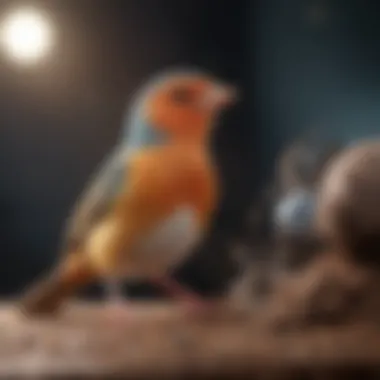
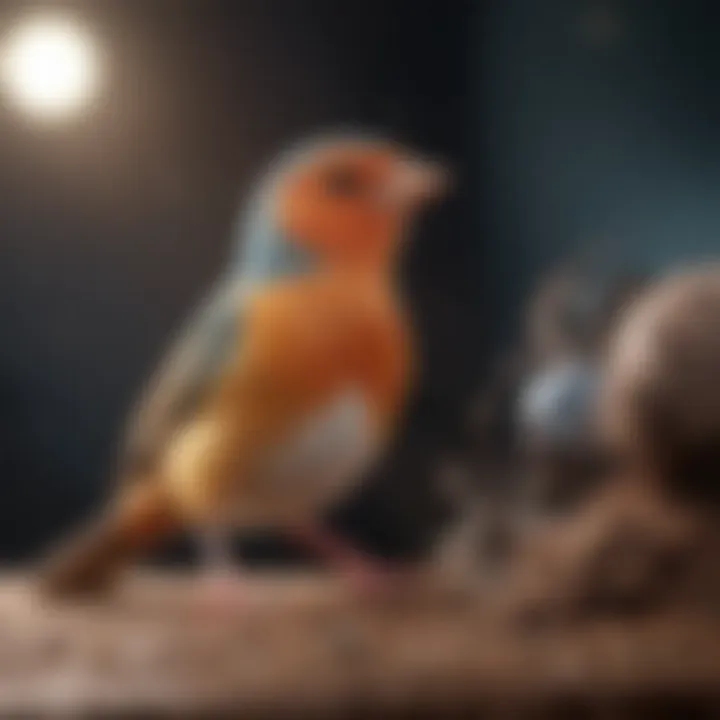
- Material Resilience: It’s best to opt for dispensers made from durable materials that can withstand chewing and pecking.
- Ease of Cleaning: Look for designs that can be easily taken apart for thorough cleaning. This is essential to prevent mold and bacteria growth.
- Adjustability: Some dispensers allow you to control how much food is dispensed, which can be beneficial for managing your bird’s diet effectively.
"Keeping bird food contained and hygienic can reduce health risks and promote better eating habits."
Fresh Food Storage Solutions
Storing fresh produce is crucial but often overlooked. Birds enjoy their fresh fruits and veggies, but without proper storage, they can spoil quickly. Consider investing in airtight containers, which can help keep food fresh and prevent unwanted pests. This goes a long way in ensuring your birds get the maximum nutritional value from their meals.
When selecting fresh food storage solutions, consider:
- Seal Quality: Ensure that the containers have a robust sealing mechanism to maintain freshness.
- Visibility: Clear containers allow you to see what’s inside, making it easier to track freshness.
- Size Options: Depending on the quantity of food you prepare, you might need a variety of sizes. Smaller containers may work best for daily servings, while larger ones can be used for bulk storage.
Supplementary Dietary Tools
While seeds and pellets are the foundation of a bird's diet, supplementary tools can add variety and essential nutrients. Items like cuttlebone or mineral blocks can help with beak maintenance, while specialized dishes for different food types can aid in presentation and accessibility. Additionally, for those who want to venture into the world of home-cooked bird meals, food processors might also be a handy tool.
Important supplementary tools to consider:
- Cuttlebones: Provides calcium and helps keep beaks trim.
- Mineral Blocks: Offers essential trace minerals that might be lacking in their primary diet.
- Food Processors: Ideal for blending up fresh foods into manageable sizes or for making bird-safe treats.
Maintaining a varied and engaging diet for your pet birds not only promotes their health but also impacts their overall happiness. The right dietary equipment can make a world of difference in how you care for your feathered friends.
Enrichment Tools for Mental Stimulation
Keeping pet birds is not just about feeding and ensuring their housing is adequate; it is also about providing them with an environment rich in stimulation. Enrichment tools contribute directly to a bird's mental health by engaging their natural instincts, encouraging their intellect, and preventing boredom. These tools help create an engaging habitat, ensuring that birds remain active and happy.
Toys for Interaction
Toys are perhaps the most visible form of enrichment for birds. They come in a range of shapes, sizes, and functionalities, aimed at engaging different species and individual preferences. Interactive toys can mimic natural behaviors, such as foraging, chewing, and climbing. Birds, like a playful parrot, need interaction and mental challenges. Here are some types of toys to consider:
- Chewable Toys: Ideal for beaks that like to gnaw. These toys help wear down the beak while providing fun.
- Puzzle Toys: These require the bird to solve a problem to access a treat, stimulating their natural foraging instincts.
- Hanging Toys: Swinging and climbing helps with physical coordination as well.
When choosing toys, keep in mind the size and preferences of your bird. It's worth rotating toys regularly to maintain interest. Variety is not just the spice of life; for birds, it is a necessity!
Foraging Devices
Foraging devices play a crucial role in encouraging birds to express their natural foraging behavior. In the wild, birds spend a good part of their day searching for food, and replicating this behavior at home is important. These devices often come in the form of puzzles or hidden compartments.
- Treat Dispensers: Birds can work to get their snacks out, making the process of eating more engaging.
- Hidden Food Toys: These toys challenge the bird to uncover their food, promoting a sense of achievement.
- Foraging Mats: These mats allow for a spread of food that birds can search through, mirroring natural feeding.
Implementing these devices can help maintain your bird's interest during feeding times, thus reducing anxiety and promoting healthier eating habits.
Climbing Structures
Climbing structures are not merely recreational; they provide physical and mental challenges for birds. These setups can include ropes, ladders, and bridges, which allow birds to navigate their space actively. For instance, a cockatiel often enjoys jumping from perch to perch or climbing through tubes.
- Rope Perches: Flexible and easy to shape, offering a way for birds to exercise their feet and claws.
- Ladders and Ramps: Provide a fun way to move around, making exercise part of the play.
- Multi-level Play Gyms: These encourage exploration and allow birds to experience different heights in a safe manner.
Integrating climbing structures into your bird's environment allows them to develop coordination, gain confidence, and engage in exploratory behavior, keeping both body and mind fit.
"A bored bird is an unhappy bird, and a happy bird makes a happy home!"
Having a well-rounded set of enrichment tools can enhance your bird's life immensely. The mental stimulation from toys, foraging challenges, and climbing structures should be tailored to your specific bird's preferences and natural behaviors, creating an engaging environment for your feathered companion.
Safety Equipment and Upgrades
When it comes to providing a secure environment for your feathered companion, safety equipment and upgrades cannot be merely an afterthought. A pet bird's well-being hinges upon both a secure living space and safe play areas. This section will explore essential components that protect these delicate creatures and help ensure their well-being.
Cage Locking Mechanisms
Cage locking mechanisms might seem like a minor detail, but they play a significant role in the safety of your bird. These mechanisms are the first line of defense against potential escape. A cockatoo, for example, is known for its cleverness and beak strength, which means that a simple latch might not cut it. Investing in a reliable locking system can prevent accidents and unexpected outings.
Birds, with their inquisitive nature, have a knack for getting into trouble. Choosing cages with locks that require a bit of strategy to open can be a boon for pet owners.
- Types of Locks:
- Sliding bolt locks are commonly found but can easily be defeated by clever beaks.
- Double locks provide an extra layer of security, making it difficult for the cleverest of birds.
- Locking trays, which secure food and water containers, can also prevent spillage and mess, thus maintaining cleanliness.
Upgrading your cage with reliable locking systems is not just about keeping your bird in; it is also about keeping unwanted visitors out. This consideration becomes particularly crucial if you own more than one pet. For instance, inquisitive cats or playful dogs may find birds to be fascinating entertainment.
Safe Toys: Materials and Selection
Toys are essential for birds' mental stimulation and physical health, but not all toys are created equal. Selecting safe materials is crucial for preventing harmful ingestion or exposure to toxic substances.
- Materials to Avoid:
- Recommended Materials:
- Lead, which is found in older toys.
- PVC plastic can contain harmful chemicals.
- Untreated wood, which may harbor pests or mold.
- Natural wood is often the safest choice, especially bamboo or untreated pine.
- Stainless steel is great for construction, ensuring durability against chewing.
- Sisal rope or cotton is safe for climbing toys.
As a bird owner, reading the labels and understanding the materials before making a purchase can assist in safeguarding your pet's health. Additionally, rotating toys regularly can keep their environment engaging while ensuring continued interest and physical activity.
Environmental Safety Measures
Ensuring your bird's safety goes beyond just the cage and toys. The overall environment needs an extra layer of consideration for potential dangers.
- Avoiding Toxic Plants: It’s important to research the plants that you have at home. Bamboo and spider plants are often fine, while things like azaleas, tulips, and poinsettias can be lethal.
- Maintaining Cleanliness: Regular cleaning of the cage and surrounding areas can help prevent illness. Bird droppings and leftover food can attract pests if left unchecked.
- Proper Ventilation: Birds, with their sensitive respiratory systems, can be affected by aerosol sprays, cigarette smoke, or even household dust. Proper ventilation and avoiding exposure to harmful substances can create a safer space for your pet.
"Ensuring your bird's environment is safe is as critical as the equipment you choose. Every little detail counts when it comes to providing a nurturing space."
Evaluating Equipment for Specific Bird Species
When it comes to caring for pet birds, one size does not fit all. Every bird species has its own unique needs and characteristics, making it crucial for owners to evaluate equipment based on the specific types of birds they have. This section emphasizes the importance of tailoring equipment to meet the distinct requirements of various avian companions, ensuring that they thrive in their environments.
By focusing on the differences in size, behavior, and habitat preferences, owners can make informed decisions about the equipment they purchase. Not only does this customization enhance the well-being of the birds, but it also enriches their lives, allowing them to exhibit natural behaviors. Well-suited equipment can lead to healthier, happier birds, and a more fulfilling ownership experience.
Cages for Parrots
Parrots are like the social butterflies of the bird kingdom. They need spacious cages that offer plenty of room to move about, spread their wings, and exercise. A cage meant for a parrot should be large, ideally at least 24 x 24 x 36 inches, to give them the freedom they crave. Additionally, a cage’s design must consider the parrot's curiosity.
Considerations for Parrot Cages:
- Bar Spacing: The spacing between the bars should be narrow enough to prevent escape, typically no wider than half an inch for medium-sized parrots.
- Accessibility: Look for cages with multiple access points and removable trays to facilitate cleaning and feeding.
- Toys and Perches: Parrots love to play and climb, so the cage should be outfitted with various perches, preferably made from different materials like natural wood for added stimulation.
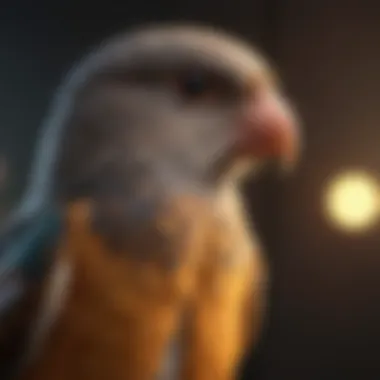
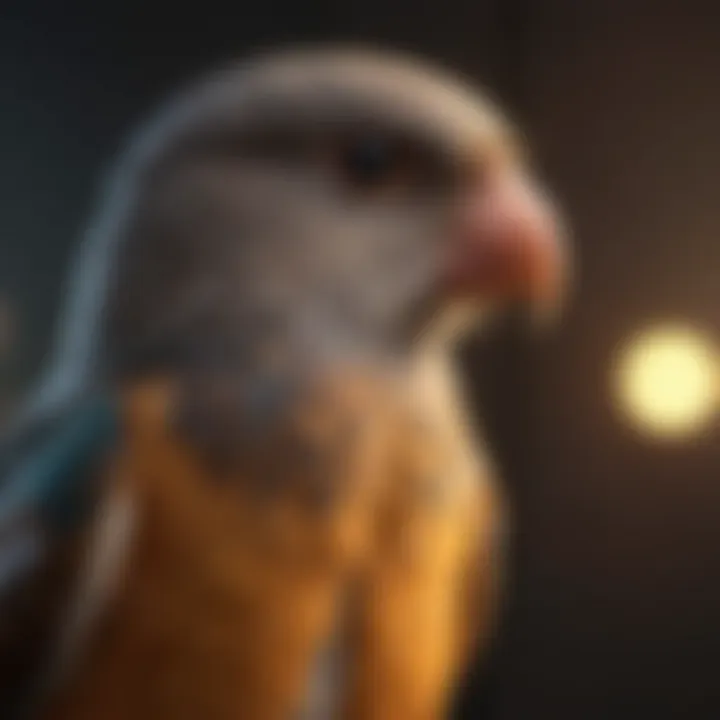
A well-designed cage acts not just as a home, but as a playground for vibrant parrots.
Accessories for Canaries and Finches
Canaries and finches are a different kettle of fish. These small, colorful birds thrive in more compact, yet comfortable spaces. When considering accessories for these species, think lightweight and safe materials.
Key Accessories for Canaries and Finches:
- Feeding Systems: These birds benefit greatly from shallow dishes. They often prefer daily fresh food, as their beaks are not designed for seeds that sit in deeper bowls.
- Nesting Areas: Offering a cozy nesting box that’s appropriate for their size promotes a sense of security and encourages natural behaviors.
- Bathing Options: A small, shallow bath or a misting system should also be considered, as these birds love to wash their feathers and stay clean.
Specialized Equipment for Cockatoos
Cockatoos are known for their affectionate nature and intelligence. These birds need a fair but firm hand, and their equipment should encourage interaction and mental stimulation. Specialized equipment might include large, interactive toys and elaborate climbing structures.
Unique Equipment for Cockatoos:
- Platform Perches: Consider installing several platform perches at different heights. Cockatoos are natural climbers and will enjoy the exercise.
- Interactive Toys: Toys that promote problem-solving, like treat-dispensing puzzles, can keep them engaged and prevent boredom.
- Secure Play Areas: Given their curious nature, having a safe, enclosed area for them to explore outside their cage is essential.
By evaluating equipment specific to the species of bird, owners can create an enriching environment tailored to their pets' distinct behavioral habits and physical needs. This pivotal focus not only fosters healthy living but also nurtures the bonds between owner and bird.
Maintenance and Upkeep of Bird Equipment
In the realm of pet bird care, the maintenance and upkeep of bird equipment should not be an afterthought. Just like a spruced-up house speaks volumes about the owners, a well-kept environment reflects directly on the health and happiness of your feathered friend. Proper maintenance is not merely about aesthetics; it's about ensuring safety and fostering a stimulating environment for your bird. Equipment that’s well-maintained enhances your bird’s quality of life, reduces health risks, and ultimately leads to a happier, more vibrant pet.
Cleaning Protocols and Recommendations
Keeping equipment clean is paramount. Birds, by nature, can be messy creatures. Droppings, spills, and food debris can accumulate quicker than one might think. Regular cleaning helps prevent the growth of bacteria and mold, which can lead to illness.
Some recommendations for cleaning include:
- Daily: Wipe down perches and food containers to keep them hygienic.
- Weekly: Conduct a thorough cleaning of the cage, removing all accessories to scrub surfaces.
- Monthly: Disinfect all equipment using safe cleaning solutions, ensuring you rinse thoroughly to get rid of any residue.
Taking care to use bird-safe cleaning products is essential. There are plenty of commercially available cleaners that are designed to kill germs without leaving harmful residues. Always read labels, and when in doubt, stick to vinegar or baking soda as natural alternatives.
Regular Equipment Inspections
Just like a car, bird equipment requires inspections. It’s easy to overlook wear and tear, but neglecting this aspect can lead to severe consequences. Regular checks help identify potential hazards before they become a problem.
Here's what to look for during your inspections:
- Cage Integrity: Ensure there are no rust spots or broken bars.
- Toys: Check for fraying ropes or broken parts that can injure your bird.
- Perches: Look for splinters or wear that might affect grip.
Making a checklist can streamline this process, and it might be good to set specific days each month to conduct these inspections, ensuring you won’t forget.
Sourcing Replacement Parts
Equipment doesn’t last forever. Knowing how to source replacement parts is a crucial aspect of bird care. For example, when a perch wobbles or a feeder breaks, immediate replacement is necessary to avoid stress for your pet.
Some tips on finding replacements include:
- Contacting Manufacturers: Reach out to companies that made your equipment. Many firms offer replacement parts for their products.
- Local Pet Stores: Often, they carry commonly used accessories such as feeders, water containers, and perches.
- Online Platforms: Websites like Amazon or specialized bird care resources often have vast selections.
Additionally, keeping some spare parts on hand could save you a hassle when an urgent replacement is needed. And remember, it’s always best to invest in quality products in the first place, as these are likely to last longer and require less frequent replacements.
"A stitch in time saves nine" - applying this saying to bird care can avert a multitude of future troubles.
Dodging the maintenance aspect could lead to unforeseen troubles down the line, making life more difficult for both you and your avian companion. Thus, by prioritizing the upkeep of bird equipment, you not only safeguard the physical health of your pet but enhance the overall caregiving experience.
Cost Considerations in Bird Equipment
When it comes to keeping pet birds, one cannot overlook the financial aspects of their care. Equipping your aviary can be a substantial investment, and understanding the costs involved is vital for pet owners, bird enthusiasts, and breeders alike. This section will explore various financial considerations, emphasizing why budgeting effectively is crucial for your feathered friends' well-being.
Budgeting for Initial Setup
Setting up a bird-friendly environment from the get-go requires careful planning and a clear understanding of expenses. You’ll need to consider the basic necessities:
- Quality Cage: A spacious and safe cage is essential for any pet bird. Depending on the species, you might spend anywhere from fifty to several hundred dollars.
- Perches and Toys: Birds need stimulation, and perches of various shapes, textures, and bird-safe toys can cost around one to two hundred dollars initially.
- Food and Water Containers: Depending on your setup, basic feeder systems may range from ten to fifty dollars.
Planning these costs ahead of time ensures you are not caught off guard. Remember, while it is tempting to skimp during the initial phase, cutting corners on essential items can lead to unforeseen expenses down the line, impacting your bird's happiness and health.
Long-Term Investment in Equipment Quality
Investing in high-quality equipment often pays off in the long run. Cheaper alternatives may seem budget-friendly, but they can fall apart quickly, leading to added replacement costs. Consider these advantages of opting for better quality:
- Durability: Quality items tend to withstand wear and tear, saving you money on replacements.
- Safety: High-quality cages and accessories have tighter safety standards. Lower-priced items sometimes use subpar materials, which might be harmful.
- Enhanced Experience for Birds: Quality products often translate into better overall experiences for your pets, resulting in a happier and healthier bird.
While it may require a larger upfront cost, investing in good stuff can reduce maintenance costs over time and ensure that your bird has the safest and most comfortable environment possible.
Comparing Affordable vs. Premium Options
When it comes time to purchase equipment, pet bird owners often wrestle with whether to choose affordable options or shell out for premium items. Here are some points to weigh:
- Affordable Options:
- Premium Options:
- Pros: Lower initial investment and more accessible for budgeting.
- Cons: May lack durability and could need replacing sooner. Often less safe for birds.
- Pros: Typically constructed from better materials and designed with longevity in mind. They provide a safer habitat for your pet.
- Cons: Higher initial costs.
"Investing in quality is a practice that blooms over time, much like nurturing a plant. The roots you plant now will support your bird’s health long into the future."
Ultimately, thorough research and understanding your bird's needs should guide your decisions, ensuring that both you and your pet can thrive without financial surprises.
End
In the caring of pet birds, reaching the right conclusion is pivotal. This article not only sheds light on the essentials of bird equipment but also highlights the intricate balance between comfort, safety, and enrichment. The well-being of pet birds is fundamentally tied to the environment and tools that their owners provide.
Recap of Essential Equipment
To summarize, here are the critical items discussed:
- Cage: The right size and structure is crucial for a bird’s comfort.
- Perches: Varied perches enhance foot health and provide a natural environment.
- Food and Water Dishes: These must be secure and easy to clean to ensure optimum nutrition.
- Toys: Providing engagement through toys is vital for mental stimulation.
- Safety Mechanisms: Elements like locking mechanisms on cages prevent accidents and keep birds secure.
- Cleaning Supplies: Essentials for maintaining hygiene and a healthy habitat.
- Diagnostic Tools: Having the right tools for health checks can prevent small issues from escalating.
Each piece of equipment plays a role in shaping a bird’s experience at home, influencing not just their physical health but also their mental state. The proper selection and maintenance of these items are paramount for any bird owner.
Final Thoughts on Optimal Bird Care
Caring for pet birds goes beyond mere feeding and housing; it necessitates a vigilant approach toward their overall environment. A thoughtful bird owner will seek to ensure that every inch of their pet's surroundings is aligned with their species-specific needs.
- Flexibility: Be prepared to adapt and expand your setup as your bird grows or changes.
- Observation: Regularly assessing your bird’s interaction with their environment will provide insights into their needs.
- Community and Resources: Connecting with other bird owners can provide recommendations and share experiences that may benefit your bird’s well-being.
At the end of the day, the investment in quality equipment is not just about money; it’s about nurturing a relationship that promotes a happy, healthy bird. Taking time to learn and understand their specific requirements pays dividends in companionship and joy.















